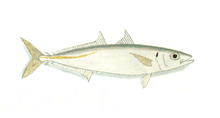Mackerel scad
| Mackerel scad | |
|---|---|
 | |
| Mackerel scad (Decapterus macarellus) | |
| Scientific classification | |
| Kingdom: | Animalia |
| Phylum: | Chordata |
| Class: | Actinopterygii |
| Order: | Perciformes |
| Family: | Carangidae |
| Genus: | Decapterus |
| Species: | D. macarellus |
| Binomial name | |
| Decapterus macarellus (G. Cuvier, 1833) | |
The mackerel scad, Decapterus macarellus, is a species of fish of the family, Carangidae. While mackerel scad can be considered gamefish, they are usually used as bait.[1]
Description

The largest mackerel scad recorded was 46 cm long.[2] Their elongated bodies look somewhat circular when viewed head on.[1] They are distinguishable by a small, detached fin, located between the dorsal and caudal fins.[3] Mackerel scad have 9 spines and 31-36 rays on their dorsal fins, while there are seven spines and 27-30 rays on their anal fins.[1]
The mackerel scad's fins are black metallic to blue-green and its belly is white.[1] The edge of the operculum has a small, black spot,[4] with no spots on the lateral line.[5] Mackerel scad's caudal fins have been described as reddish [5] to yellow-green.[4]
Distribution and habitat
The mackerel scad's range covers most of the world's oceans. In the western Atlantic, they have been found off Nova Scotia and Bermuda, south to Rio de Janeiro,[6] although they do not seem common in the Gulf of Mexico.[7] In the eastern Atlantic, mackerel scad have been found off St. Helena, Ascension Island, and Cape Verde.[8] They have also been recorded in the Gulf of Guinea,[8] The Azores, and Madeira.[9] In the Indian ocean, mackerel scad have been found in the Red sea and the Gulf of Aden they are also known from South Africa, the Mascarenes, the Seychelles, and Sri Lanka.[10] In the eastern Pacific, they are known from Revillagigedo Island, the Gulf of California, and the coast of Ecuador.[11]
FAO areas where the Mackerel scad is native include the north east and northwest Atlantic, the center east and west Atlantic, the Mediterranean sea and the Black sea, the South east and west Atlantic, the eastern and western Indian, and the North west, center west, center east and south west Pacific.[1]
Mackerel scad usually live in subtropical seas at depths up to 400 m.[1] They prefer clear water, and are frequently found around islands.[12] Although mackerel scad have been found at the surface, they are usually caught at depths between 40 and 200 meters. They feed mainly on zooplankton.[13]
Economic significance
Mackerel scad are fairly important both to fisheries and to sportfishing.[1] They can be used as food, but are known to carry ciguatera,[14] and are more often used as bait, since large gamefish such as the blue-spotted grouper, giant trevally, and the onespot snapper are all known to feed on them.[15][16]
References
- ↑ 1.0 1.1 1.2 1.3 1.4 1.5 1.6 "Fishbase.org entry on Mackerel scad". Retrieved 2012-12-16.
- ↑ Jiménez Prado, P. & P. Béarez, 2004. Peces Marinos del Ecuador continental. Tomo 2: Guía de Especies / Marine fishes of continental Ecuador. Volume 2: Species Guide. SIMBIOE/NAZCA/IFEA
- ↑ "GMA.org entry on Mackerel scad". Retrieved 2008-08-20.
- ↑ 4.0 4.1 Smith-Vaniz, W.F., 1986. Carangidae. p. 638-661. In M.M. Smith and P.C. Heemstra (eds.) Smiths' sea fishes. Springer-Verlag, Berlin.
- ↑ 5.0 5.1 Randall, J.E. 1996 Caribbean reef fishes. Third edition - revised and enlarged. T.F.H. Publications, Inc. Ltd., Hong Kong. 3rd ed. 368 p.
- ↑ Floeter, S.R., J.L. Gasparini, L.A. Rocha, C.E.L. Ferreira, C.A. Rangel and B.M. Feitoza, 2003. Brazilian reef fish fauna: checklist and remarks (updated Jan. 2003). Brazilian Reef Fish Project: www.brazilianreeffish.cjb.net.
- ↑ Cervigón, F. 1993 Los peces marinos de Venezuela. Volume 2. Fundación Científica Los Roques, Caracas,Venezuela. 497 p.
- ↑ 8.0 8.1 Smith-Vaniz, W.F., J.C. Quéro and M. Desoutter, 1990. Carangidae. p. 729-755. In J.C. Quero, J.C. Hureau, C. Karrer, A. Post and L. Saldanha (eds.) Check-list of the fishes of the eastern tropical Atlantic (CLOFETA). JNICT, Lisbon; SEI, Paris; and UNESCO, Paris. Vol. 2.
- ↑ Smith-Vaniz, W.F., 1986. Carangidae. p. 815-844. In P.J.P. Whitehead, M.-L. Bauchot, J.-C. Hureau, J. Nielsen and E. Tortonese (eds.) Fishes of the north-eastern Atlantic and the Mediterranean. UNESCO, Paris. vol. 2.
- ↑ Smith-Vaniz, W.F., 1984. Carangidae. In W. Fischer and G. Bianchi (eds.) FAO species identification sheets for fishery purposes. Western Indian Ocean fishing area 51. Vol. 1. [pag. var.]. FAO, Rome.
- ↑ Smith-Vaniz, W.F., 1995. Carangidae. Jureles, pámpanos, cojinúas, zapateros, cocineros, casabes, macarelas, chicharros, jorobados, medregales, pez pilota. p. 940-986. In W. Fischer, F. Krupp, W. Schneider, C. Sommer, K.E. Carpenter and V. Niem (eds.) Guia FAO para Identification de Especies para lo Fines de la Pesca. Pacifico Centro-Oriental. 3 Vols. FAO, Rome.
- ↑ Cervigón, F., R. Cipriani, W. Fischer, L. Garibaldi, M. Hendrickx, A.J. Lemus, R. Márquez, J.M. Poutiers, G. Robaina and B. Rodriguez, 1992. Fichas FAO de identificación de especies para los fines de la pesca. Guía de campo de las especies comerciales marinas y de aquas salobres de la costa septentrional de Sur América. FAO, Rome. 513 p. Preparado con el financiamento de la Comisión de Comunidades Europeas y de NORAD.
- ↑ Smith-Vaniz, W.F., 1995. Carangidae. Jureles, pàmpanos, cojinùas, zapateros, cocineros, casabes, macarelas, chicharros, jorobados, medregales, pez pilota. p. 940-986. In W. Fischer, F. Krupp, W. Schneider, C. Sommer, K.E. Carpenter and V. Niem (eds.) Guia FAO para Identification de Especies para lo Fines de la Pesca. Pacifico Centro-Oriental. 3 Vols. FAO, Rome.
- ↑ Coupal, L., E. Bédard, C. Peguero and I.S. Durante 1992 Repertorio ictionímici de la República Dominicana. Fáscículo I : Acanthuridae - Carangidae. LIRD.
- ↑ Randall, J.E. and V.E. Brock 1960 Observations on the ecology of Epinephelinae and lutjanid fishes of the Society Islands, with emphasis on food habits. Trans. Am. Fish. Soc. 89(1):9-16.
- ↑ Sudekum, A.E., J.D. Parrish, R.L. Radtke and S. Ralston, 1991
External links
- http://www.gma.org/fogm/Decapterus_macarellus.htm
- http://www.thejump.net/id/mackerel-scad.htm
- http://www.fishbase.org/summary/SpeciesSummary.php?id=993
